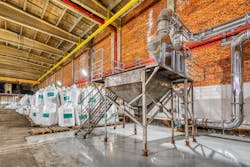The need for and importance of pilot testing in bulk solids storage, handling and conveying cannot be underestimated. Handling bulk solids involves solving a complex and wicked problem that cannot be addressed using only experience and existing broad-based knowledge; it needs continuous attention because storage and conveying issues can’t be resolved completely.
Powders and bulk solids behavior is complex due to variations in physical properties such as particle size and distribution as well as particle shape — for example, sugar, plastic pellets, food, chemicals and pharmaceutical powders. Further, materials often are susceptible to variations in properties due to environmental factors such as temperature, relative humidity and moisture content that can cause caking, agglomeration, cohesiveness and levels compaction.
Bulk solids property changes in every aspect of conveying and storage. For example, a friable material will degrade during dilute-phase pneumatic conveying because of high-velocity air, and highly cohesive material compacts during storage and forms caking. These properties determine the material flow characteristics in the bin, hopper, chute, feeder and pneumatic/mechanical conveying systems. They also are essential in designing pneumatic conveying systems.
Pneumatic conveying systems are becoming the preferred technology to convey powders and bulk solids. The majority of processing industries — food, chemicals, plastics and minerals — require powder or bulk solids handling or storage systems or equipment. Materials conveying performance is critical in specifying, designing or retrofitting a conveying technology to avoid flowability problems.
This performance includes evaluating important conveying characteristics such as pickup velocity, pressure drop, inlet airflow rate (ICFM), solid-load ratio and can velocity at filter. Across the bulk solids industry, manufacturers, developers and operators of pneumatic conveying systems, products and components need to ensure that the bulk solids pneumatic conveying systems are up to their intended tasks. No matter how you design and build a system, there always will be a few bumps along the way when operating it when material properties or operating conditions change, causing flow problems leading to inadequate performance.
Further, in today’s challenging and complex marketplace, businesses need to step up to meet end user requirements. This may involve spending millions of dollars to improve existing systems as well as developing new systems and equipment. This is an investment for any company, but small and medium-size companies tend to be more price-sensitive. The solution to achieving peace of mind and taking the best step forward is, above all, through pilot testing.
Whether you are specifying, designing or improving a poorly run conveying system, conducting pilot tests and having a thorough understanding of flow properties and conveying characteristics will result in avoiding material flow problems and costly mistakes and increasing sustainable, reliable and smooth operations. In addition, it provides a better foundation for the correct system design, equipment selection and efficient processes. Moreover, pilot testing will ensure you know your system or the system you need and identify the key properties to operate your system efficiently, protecting your company’s investment. This article will cover what pilot testing is, why it’s important, what the key considerations are and what to look for in a pilot plant facility.
Why to Pilot Test
Acquired knowledge of bulk solids handling mostly is empirical, meaning it is gathered based on experience and limited experiments. The main problem with this knowledge is it applies only to a particular material and its environmental conditions and may not work for similar or other material because of variations in material properties.
Most empirical and science-based knowledge is protected within the industry’s intellectual property rights. Most of these industries are original equipment manufacturers (OEMs). Even these OEMs or industry experts will not make a decision on material conveying characteristics without testing the material for its characteristics. The science of full-scale material handling is totally different from bench scale testing. The successfully identified flow property based on the bench scale may not work in full scale if the characteristics change. It would be hard to determine the property in full-scale.
From an economic perspective, pilot testing becomes necessary when companies are more price-sensitive, have limited budgets or are under pressure to control costs. Traditionally, large companies have been well-equipped with their own in-house pilot test facilities. In-house pilot testing requires significant time, resources and capacity. However, some companies are not able to manage resources in terms of systems, equipment and expertise to support in-house pneumatic conveying systems testing.
In addition, the pilot test facility, state-of-the-art instrumentation, data collection, air filtration systems, dust control systems and explosion-proof installations require more expensive equipment. The facility must be suitable for testing and development of applied research work and be able to convey test demonstrations to potential customers. The facility also can be used for education and training.
Ultimately the pilot test facility will set the basis for specifying, improving or designing a large-scale conveying system. Further, the personnel running the system must be well-trained, with years of experience. The knowledge and experience necessary to run and maintain these test facilities seldom are available in the powder and bulk solids industry.
To Pilot Test or Not?
Several in the powder and bulk solids industry contemplate this question every year. Most of us often face the need for an existing plant to increase output or production, optimize conveying conditions and modify or replace plant equipment, and we realize that system is not capable of rated duty. The industry doesn’t always have the luxury of halting production in a conveying plant running near capacity for experimental runs with simple modifications to address the issues or test new products or processes. That’s what makes a pilot plant so important.
For new powder or bulk solid conveying, pilot testing is a way to assess commercial run viability and offers a place to see how variations in material properties impact material flow and conveying parameters. It also is a place to experiment with new equipment and processes. Other reasons to pilot test are to:
• Validate and verify expected operating conditions, results and relationships
• Test and validate the benefit of proposed solutions
• Understand expected variation in the conveying process
• Reduce the risk of failure by limiting resource use
• Improve the ability to better predict cost savings from a proposed solution
• Quickly deliver a version of a solution to a particular segment
• Validate the measurement system
What Is Pilot Testing?
In the bulk solids industry, pilot testing is the evaluation of conveying systems and equipment for a limited time and at a limited scale under real-time operating conditions to understand systems performance and determine the design and operating conditions. It essentially is a practice run, a test similar to using a flight simulator before you fly a jumbo jet. Pilot testing usually is done to compare different processes, operating conditions, systems or equipment to determine which will work best for handling a specific powder or bulk solid.
Pilot testing also is done for a specific conveying technology to determine the system or equipment design parameters for full installation. Further, existing processes and operations can be simulated using pilot test facilities to assess the impact of material conveying or troubleshoot problems without interrupting main plant operations.
A pilot testing facility includes a precommercial pneumatic conveying system with new conveying technology. It should be unique in that it operates in an integrated fashion, such that it should be capable of both dilute- and dense-phase conveying with high material flow rates. Finally, it is beneficial to use a facility that is flexible and modular in providing test capabilities.
Center Offers Extensive Capabilities.
Opening five years ago, Kansas State University Bulk Solids Innovation Center (BSIC) is the only university facility and staff in North America dedicated to helping industrial companies with education, consulting, testing services and research related to powder and bulk solids. With 13,000 sq ft, the facility includes six laboratory rooms with test bench equipment for measurement and characterization of material properties, while providing additional room for client research projects.
BSIC features a full-scale bay with a variety of equipment for testing and studying hopper flow, chutes, conveying, filtering, flow aids, blending, separating and the like. The facility is filled with state-of-the-art equipment and instrumentation. The center’s full-scale pilot test facility features 3-, 4-, and 6-in. pneumatic conveying lines capable of conveying up to 920 ft horizontally and 65 ft vertically.
Key Considerations
Pilot plant testing helps customers to mitigate risks and plan for business success. Before initiating a pilot test, assess the need and the amount of risk to the business. When planning to conduct pilot testing, the following items should be considered:
1. Identify the facility and its capabilities to conduct pilot testing.
2. Discuss your timing, anticipated project scope and financial requirements.
3. Develop a work scope statement.
4. Collect data and performance of the current method of conveying under various conditions, including seasonal changes and operating conditions.
5. Look at alternatives and technologies being considered, including where they have been used and the performance at those locations.
6. Determine the need for bench testing that would aid in the design of the pilot test.
7. Know the schematics and design data of the actual processes proposed for the pilot testing. The design data sheets should include but not be limited to the physical dimensions, material physical properties and expected flow rates.
8. Determine specific operational and performance characteristics.
9. Decide on the specific test methodology, if required.
10. Be aware of requirements of a written report.
Final Thoughts
In today’s challenging and complex marketplace and from an economic perspective, outsourcing pilot testing becomes necessary when companies need to control costs and operate in a cost-effective way. Owning and maintaining equipment to measure physical properties and determine conveying characteristics of powders and bulk solids is expensive. The trend for outsourcing pilot testing is growing. Ultimately, the decision to test depends on the project timeline, cost constraints and business needs. The upfront pilot testing will lower the project risk. If the project risk is low, peace of mind and benefits offered are plentiful and difficult to ignore and will outweigh the risk.
About the Author
Raju Dandu
KSU-Bulk Solids Innovation Center
Raju Dandu is the director of the KSU-Bulk Solids Innovation Center.

